Ijraset Journal For Research in Applied Science and Engineering Technology
- Home / Ijraset
- On This Page
- Abstract
- Introduction
- Conclusion
- References
- Copyright
Developing a Mobile Application for IoT-Powered Health Monitoring Systems
Authors: A Kanagaraj, Poonam Joshi, Rajarajeswari S, Prasanth Kamma, Gurjinderpal Singh, Manoj Kumar Tiwari
DOI Link: https://doi.org/10.22214/ijraset.2024.64101
Certificate: View Certificate
Abstract
A multidisciplinary approach is typically required to address health issues effectively in medical emergencies. Traditional sensor-based diagnostics in healthcare, when applied on a large scale, demand numerous sensors and significant human intervention. To address these challenges, this research proposes an IoT-based healthcare application designed to streamline patient monitoring. The system is built around an online mobile application that enables continuous, wireless observation of patients\' health. The primary objective is to develop a cost-effective solution that transmits vital patient parameters during emergencies. Sensors such as ECG monitors, heart rate sensors, and temperature sensors are employed to measure critical health indicators. The collected data is transmitted to the cloud via a microcontroller-connected module for storage on an IoT platform. In the cloud, the data is processed, and relevant feedback is generated, allowing doctors to assess the patient\'s condition remotely. This remote monitoring reduces the workload on healthcare professionals while ensuring accurate patient health assessments. In cases requiring urgent attention, alerts are sent to caregivers or doctors. This system aids in early intervention and enhances the quality of patient care. The proposed setup has been validated through simulations and various test experiments.
Introduction
I. INTRODUCTION
Healthcare services are often inadequate in rural areas, with many individuals lacking access to timely and high-quality medical care. This issue is particularly prevalent among agricultural communities, where financial constraints further limit access to essential healthcare services. According to our survey, a significant portion of the population in these regions only seeks medical attention when a condition has already progressed to a critical stage, exacerbating health outcomes and increasing the overall cost of care. The barriers to timely medical intervention in rural areas are multifaceted, including geographic isolation, limited healthcare infrastructure, and economic challenges that make it difficult for residents, especially farmers, to afford necessary treatments.
To address these challenges, our project proposes a streamlined yet highly effective solution that leverages the Internet of Things (IoT) to enhance healthcare delivery in rural settings. The IoT has garnered significant attention in recent years, particularly in the realm of personalized healthcare, due to its potential to revolutionize how medical services are delivered and managed [1-5]. By integrating IoT technology into healthcare systems, it is possible to overcome many of the barriers that currently impede access to quality care in rural areas. IoT-enabled healthcare solutions can continuously monitor patients' health, facilitate remote diagnosis, and enable timely interventions, thereby improving patient outcomes and reducing the burden on healthcare facilities. Medical researchers and innovators have long recognized the potential of IoT in transforming healthcare. For decades, they have worked tirelessly to develop technologies and systems that can improve health services and enhance human well-being [6, 7]. The use of IoT in healthcare is particularly promising in its ability to monitor key health indicators—such as body temperature, pulse rate, blood pressure, and respiration rate—in real-time. These vital signs are crucial for diagnosing a wide range of diseases and conditions. By continuously monitoring these parameters, IoT-based systems can detect abnormalities early, enabling prompt medical intervention and potentially saving lives. Health monitoring Based Cognitive IOT is the system to understand more about advanced monitoring in medical field [13]. Involvement of IOT in the field of artificial intelligence is the main reference to understand this proposed system [14]. Research project SANAS-net helped this projected approach to understand the accuracy finding using various graphs [15]
Our project specifically focuses on utilizing sensors to monitor body temperature and pulse rate, which are two of the most important indicators of a person's health status. The data collected by these sensors is transmitted to the cloud, where it is stored and processed using the IoT platform ThingSpeak. ThingSpeak is a powerful tool that allows for the efficient management and visualization of sensor data, making it easier for healthcare providers to monitor patients remotely and respond quickly to any changes in their condition. This capability is particularly valuable in rural areas, where access to healthcare professionals may be limited, and where patients may need to travel long distances to receive care.The integration of IoT technology into healthcare systems not only improves access to medical services but also enhances the quality of care by providing healthcare providers with more accurate and timely information. This, in turn, enables more informed decision-making and better patient outcomes. Furthermore, by reducing the need for in-person visits, IoT-based healthcare solutions can lower the overall cost of care, making it more affordable for patients in rural and agricultural communities.
In conclusion, the application of IoT in healthcare represents a significant advancement in the way medical services are delivered, particularly in underserved rural areas. By focusing on the critical parameters needed for disease diagnosis and utilizing advanced IoT platforms like ThingSpeak, our project aims to bridge the gap in healthcare access and provide a cost-effective, efficient solution that can improve the health and well-being of individuals in these communities. The continued development and implementation of IoT-based healthcare solutions hold great promise for addressing the challenges faced by rural populations and ensuring that everyone has access to the quality medical care they need.
II. LITERATURE SURVEY
The literature reviewed provides a robust foundation for understanding the current advancements in healthcare systems, particularly those that integrate machine learning algorithms and IoT-based technologies. Shoban Babu et al. [8] presented a pioneering concept where IoT is employed to monitor patient health efficiently. Their work emphasizes the early detection of disorders, a critical aspect of preventative healthcare, and outlines how IoT can be instrumental in providing timely remedies for patient recovery. Additionally, their system includes a network of sensors that plays a crucial role in alerting caregivers or medical professionals when abnormalities are detected, thereby facilitating swift responses to potential health crises.
In a similar vein, Sreekanth et al. [9] explored the collection and transmission of patient data to the cloud, where it is subsequently processed by a microcontroller. While their study highlights the importance of cloud-based data processing, it falls short in addressing the effective transmission and classification of data according to the specific needs of patients. This gap in the system's design could lead to inefficiencies in how patient data is managed and utilized for healthcare decisions.
Wan et al. [10] further contributed to this field by developing an IoT-based patient health monitoring system that connects wireless sensors from various parts of the body to a central node, which is then linked to a server. Although this system demonstrates the potential of wireless sensor networks in patient monitoring, it also reveals a significant limitation: the uncertainty of data transmitted from wireless sensors. This uncertainty can result in inaccurate health assessments, undermining the reliability of the system.
Valsalan P et al. [11] took a different approach by using Arduino to manage data collected from sensors, which were then stored in a database for future access. While their work highlights the practicality of using Arduino in healthcare applications, it lacks an Electronic Medical Record (EMR) system, which is crucial for organizing patient information in a way that is easily accessible to healthcare providers. The absence of an EMR profile limits the system's effectiveness in delivering comprehensive and continuous patient care.
Finally, Yeri V et al. [12] proposed a system aimed at remote monitoring of patient conditions. However, their approach did not incorporate RFID tags for the sensors, which are essential for systematically collecting and organizing patient data. The lack of proper data transfer mechanisms to the database and insufficient documentation further exacerbate the system's shortcomings, making it difficult to access and utilize the collected data effectively.
In summary, while these studies contribute valuable insights into the integration of IoT and machine learning in healthcare, they also highlight several limitations that need to be addressed. These include the need for more reliable data transmission methods, effective data classification according to patient needs, and incorporating comprehensive EMR systems to ensure that patient information is accessible and useful for medical decision-making.
III. METHODOLOGY
Table 1 provides an overview of the hardware components used in the development of the device. The microcontroller at the core of this setup is the Arduino UNO. Sensors such as the Max30100, Ec0567, and Ad8232 are integrated into the system and are connected to the human body to monitor various physiological parameters. Additionally, an LCD is included for data display.
A. Hardware Components
1) ESP8266 Module: The ESP8266 Module, specifically the ESP-12E development board, is equipped with an ESP8266 chip that features a 32-bit LX106 RISC microprocessor. This board operates at a clock frequency ranging from 80 MHz to 160 MHz, making it suitable for a wide range of IoT applications. The NodeMCU module, widely used in IoT projects, leverages this chip and offers 4MB of flash memory for data and program storage. It is powered via a micro-USB inlet and includes built-in Wi-Fi capabilities. The module also supports UART, SPI, and I2C interfaces, enhancing its versatility for various IoT applications.
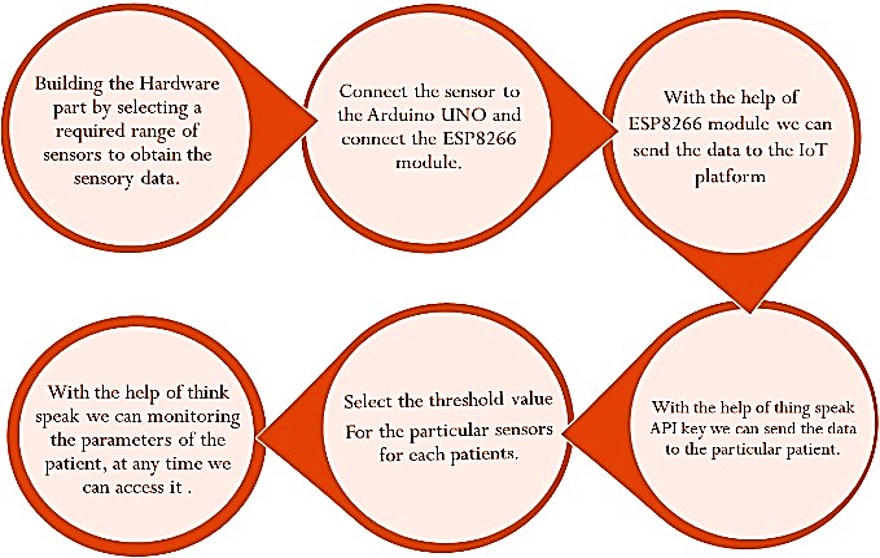
Figure 1. Methodology of the system
Table 1. Hardware Components Description
|
S.l. No |
Name of the components |
Description |
|
1 |
ESP8266 |
Send data to the MySQL Database through the Wi-Fi module. |
|
2 |
MAX30100 Pulse oximeter sensor |
Sensors are used to sense the blood oxygen level in the body. |
|
3 |
Arduino UNO R3 |
This microcontroller board is used to Relay the data from the sensors. |
|
4 |
EC-0567 heart sensor |
Detects the heart rate of the human body. |
|
5 |
AD-8232 ECG Monitor sensor |
Since the pulse rate and the output are in the waveform (ECG wave). |
|
6 |
LM35 |
The sensor is used to measure the body temperature. |
|
7 |
Thing speak |
It stores and retrieves the data sensed by the sensors. |
2) Arduino Uno: The Arduino Uno is one of the most widely used microcontroller boards, powered by the ATmega328P microcontroller. This board features 14 digital input/output pins, 6 analog input pins, a USB connection for programming and power, a single power channel, and a reset button. The Arduino Uno can be powered through a USB connection to a computer or by using an AC-to-DC adapter, making it versatile and easy to use in various projects.
3) Heart Rate Sensor: The heart rate sensor is designed to measure pulse rate by detecting changes in the volume of blood vessels as the heart pumps blood. This sensor is known for its reliability and allows real-time heart rate data to be displayed. It includes an integrated amplification and noise cancellation circuit, ensuring accurate readings. The pulse sensor operates on either a 3V or 5V DC power supply and can be easily connected to a NodeMCU or breadboard, making it user-friendly and efficient for rapid data acquisition.
4) ECG Monitor Sensor: The ECG monitor sensor is a single-chip device specifically designed to extract, amplify, and filter biopotential signals. It uses three leads that function as operational electrodes to monitor electrical activity in the heart, providing crucial data for medical assessments.
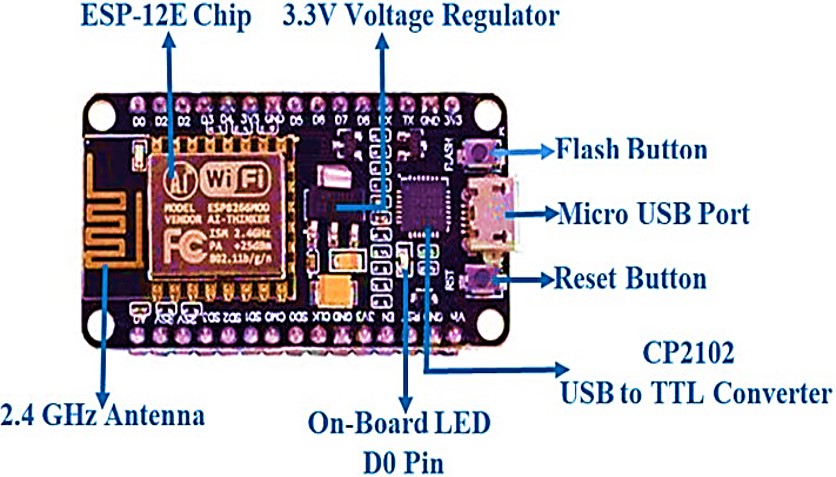
Figure 2. ESP8266

Figure 3. Arduino UNO Figure 4. Hear rate senso
Amplifier to get a clear signal. The ECG signals obtained from the patient contain more noise at the output side. In order, to overcome this issue an operational amplifier is used in the module which helps in obtaining a clear output signal.LM 35.
5) Temperature Sensor: A temperature sensor is used to detect the body temperature. It can measure the temperature in the range of -55 degrees centigrade to 150 degrees centigrade. The accuracy range of the temperature sensor is high when operated at optimal temperature and humidity levels. The input voltage on the sensor varies from 4v to 30v and also consumes a current of 50Ma.
6) Thing Speak (IoT Platform): It is an open IoT platform used to transfer data from any Internet-enabled device to the cloud. By configuring various actions and alerts it supports your real-time data and unlocks your data using visual tools. Think Speak helps the developers to a great extent by capturing the sensor data and converting it into useful information. Thing Speak server is an open service that is free of cost and helps the development of small non-commercial projects.

Figure 5. ECG monitor sensor Figure 6. Pulse oximeter
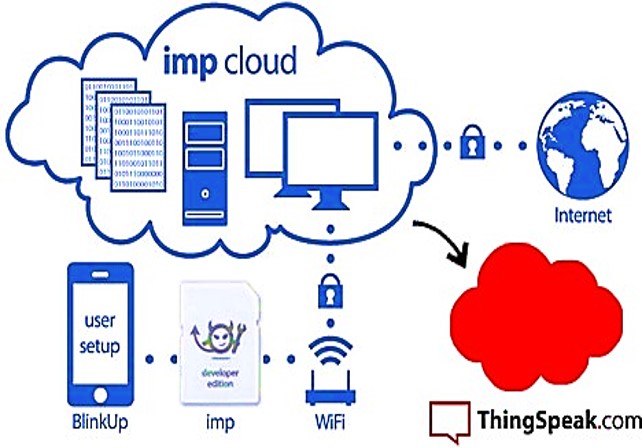
Figure 7. Overview of ThingSpeak
In this system, sensors are utilized to collect health data from patients for data acquisition purposes. The communication between hardware components is facilitated by the Arduino UNO and the ESP8266 module, which work together to send the collected data to a server. The data is transmitted to the ThingSpeak server, where it is processed and stored. This process is enabled by an API key that identifies the ThingSpeak server, ensuring that the data is directed to the correct location. Patients can access their health information via a web page hosted on ThingSpeak. The Arduino UNO plays a critical role in this system, as it collects data from each sensor and transfers it to the ThingSpeak IoT platform. The API key allows for the data to be securely transmitted to the cloud, where it can be accessed and documented as needed. Users can download the data in .CSV format, though the free version of ThingSpeak offers limited storage capacity.
The hardware components provide accurate readings of the patient's vital signs, as demonstrated in Figure 8. Sensors detect data from the patient's body, and the NodeMCU processes this information before sending it to the ThingSpeak cloud. If any of the sensor readings exceed the predefined threshold values, the data will be highlighted in red, signaling an emergency that requires immediate medical attention. This alert is sent directly to the doctor, ensuring prompt intervention. The system also allows the patient to move freely, as the sensors continuously monitor their condition. Every 20 seconds, the sensors transmit updated data to the ThingSpeak cloud via the ESP8266 module. Should any of the patient's vital signs exceed the threshold, the doctor will receive an instant alert, allowing for quick and decisive action to be taken.
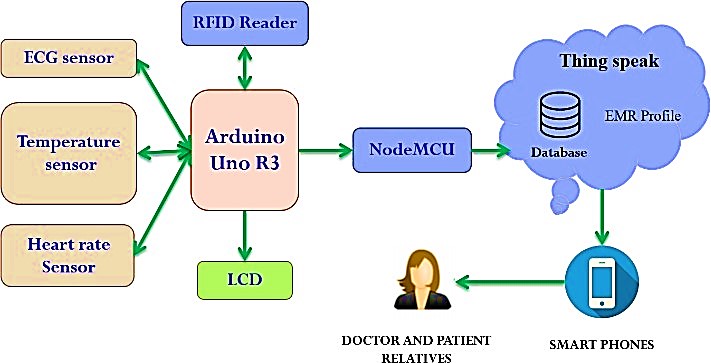
Figure. 8 Block diagram of the proposed system
This hardware setup consists of a Heart Rate sensor, ECG Monitor sensor, and temperature sensor. These sensors are used to measure and monitor the values of pulse and temperature. After the values are found out the data is sent to the microcontroller. The microcontroller takes the necessary action and decides on sending the data. The data is sent using a Wi-Fi Module and it is stored in ThingSpeak.
IV. RESULTS
This hardware configuration includes a heart rate sensor, ECG monitor sensor, and temperature sensor, all of which are used to measure and monitor pulse and temperature values. Once the readings are obtained, the data is transmitted to a microcontroller. The microcontroller then processes the information and determines whether to send the data. The data is transmitted via a Wi-Fi module and stored in ThingSpeak.

Figure 9. Hardware Setup Figure 10. Simulation on Arduino IDE
To thoroughly analyze and test the sensors integrated into our system, we utilized Arduino IDE, a versatile and widely-used software fully compatible with the microcontroller at the core of our setup. Arduino IDE allows for seamless programming, debugging, and simulation of sensor data, making it an ideal choice for this project. During the testing phase, we conducted a series of simulations to ensure the accurate functioning of the sensors and their ability to reliably collect data. The simulations provided valuable insights into how the sensors would perform in real-world scenarios, allowing us to refine the system for optimal performance.
The heart rate sensor, for instance, collects pulse data, which is then transmitted to the cloud platform ThingSpeak. ThingSpeak serves as a robust data storage and monitoring solution, enabling continuous observation of the heart rate data in real time. This real-time monitoring is crucial for promptly identifying any abnormalities or sudden changes in the patient's condition. Similarly, the ECG sensor captures electrocardiogram signals, which are also sent to ThingSpeak. This ensures that the ECG data is continuously monitored and archived for future reference or detailed analysis by healthcare professionals.
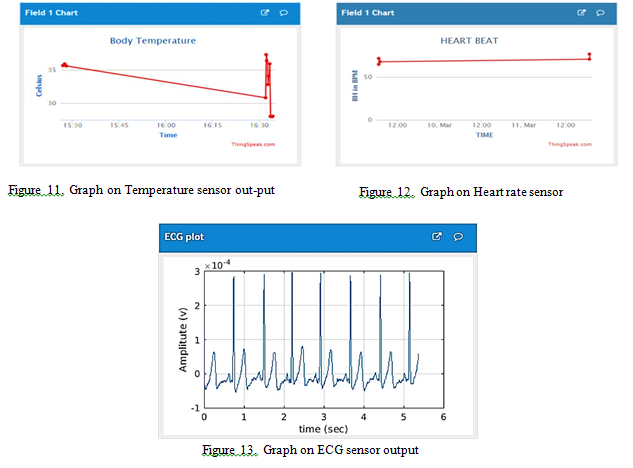
Additionally, the temperature sensor tracks the patient's body temperature, and any fluctuations are recorded and sent to ThingSpeak. The figure provided in our documentation illustrates these variations in temperature over time, demonstrating how doctors can access the data at any moment. This capability is significant for remote patient monitoring, where healthcare providers need real-time access to vital signs without being physically present.
Overall, the integration of Arduino IDE with our sensor setup and the use of ThingSpeak as a cloud-based monitoring platform enables a comprehensive and reliable system for real-time health data tracking. This setup not only enhances the ability to monitor patients remotely but also contributes to more timely and informed medical interventions.
Conclusion
The healthcare sector consistently generates a vast amount of medical data, necessitating the use of specialized methods for effective data management. One commonly employed technique in this field is data processing, which allows for efficient handling and analysis of this information. This paper emphasizes the importance of real-time data for more accurate predictions using IoT technology. The predicted data is recorded in Google Sheets for easy access and monitoring. This approach has significant potential for mass screening systems in rural areas, where hospital facilities are often unavailable. By implementing such systems, healthcare services can be extended to underserved populations, improving early detection and treatment outcomes. For future work, we plan to incorporate additional features to enhance the system\'s functionality. This includes making the device more user-friendly and automated, particularly for patients with various types of diseases. We also aim to integrate machine learning algorithms to predict diseases and provide helpful recommendations to patients, indicating whether their condition is normal or abnormal. Additionally, we will focus on developing smaller and lighter sensors for the wearable device, allowing it to measure a greater number of parameters. This will enhance the accuracy and precision of disease classification, further improving the overall effectiveness of the system.
References
[1] Prasath JS, Ramachandraiah U, Muthukumaran G. Modified Hardware Security Algorithms for Process Industries Using Internet of Things. Journal of Applied Security Research. 2021 Jan 2;16(1):127-40. [2] Prasath JS, Jayakumar S, Karthikeyan K. Real-Time Implementation for Secure monitoring of Wastew- ater Treatment Plants using Internet of Things. International Journal of Innovative Technology and Ex- ploring Engineering. 2019;9(1):2997-3002. [3] Selvanayakam A, Varishnee AC, Kalaivani M, Ranjithkumar G. Health Monitoring System Using IoT. InInnovations in Electrical and Electronics Engineering 2020 (pp. 739-750). Springer, Singapore. [4] Usha Rani S, Ignatious A, Hari B, Balavishnu V. IoT patient health monitoring system. Indian Journal of Public Health Research and Development. 2017 Oct 1;8(4)1329-34. [5] Luo Y. Environmental cost control of coal industry based on cloud computing and machine learning. Arabian Journal of Geosciences. 2021 Jun;14(12):1-6. [6] Abarna SS, Renija D, Saffana Parveen S, Saradha Preetha S. Smart wearable health monitoring sys- tem for diagnosing diseases in patients. International Research Journal of Engineering and Technology (IRJET). 2018 Feb;5(2):178-81. [7] Al-Aubidy KM, Derbas AM, Al-Mutairi AW. Real-time healthcare monitoring system using wireless sensor network. International Journal of Digital Signals and Smart Systems. 2017;1(1):26-42. [8] Shoban Babu B, Srikanth K, Ramanjaneyulu T, Lakshmi Narayana I. IoT for healthcare. International Journal of Science and Research. 2016 Feb;5(2):322-6. [9] Sreekanth KU, Nitha KP. A study on health care in Internet of Things. International journal on recent and innovation trends in computing and communication. 2016 Feb;4(2):44-7. [10] Wan J, Al-awlaqi MA, Li M, O’Grady M, Gu X, Wang J, Cao N. Wearable IoT enabled real-time health monitoring system. EURASIP Journal on Wireless Communications and Networking. 2018 Dec;2018(1):1-10. [11] Valsalan P, Baomar TA, Baabood AH. IoT based health monitoring system. Journal of critical reviews. 2020;7(4):739-43. [12] Yeri V, Shubhangi DC. IoT based Real Time Health Monitoring. In2020 Second International Confer- ence on Inventive Research in Computing Applications (ICIRCA) 2020 Jul 15 (pp. 980-984). IEEE. Yeri V, Shubhangi DC. IoT based Real Time Health Monitoring. In2020 Second International Conference on Inventive Research in Computing Applications (ICIRCA) 2020 Jul 15 (pp. 980-984). IEEE. [13] kumari, Saroj & Shrinivasa, & S, Dr & Reddy, V & P K, Manoj. (2023). HEALTH MONITORING BASED COGNITIVE IOT USING FAST MACHINE LEARNING TECHNIQUE. Shu Ju Cai Ji Yu Chu Li/Journal of Data Acquisition and Processing. 38. 405-417. 10.5281/zenodo.7648729 [14] P. M. Manjunath, Gurucharan and M. DSouza Shwetha, \"IoT Based Agricultural Robot for Monitoring Plant Health and Environment\", Journal of Emerging Technologies and Innovative Research vol. 6, no. 2, pp. 551-554, Feb 2019 [15] Melwin D\'souza, Ananth Prabhu Gurpur, Varuna Kumara, “SANAS-Net: spatial attention neural architecture search for breast cancer detection”, IAES International Journal of Artificial Intelligence (IJ-AI), Vol. 13, No. 3, September 2024, pp. 3339-3349, ISSN: 2252-8938, DOI: http://doi.org/10.11591/ijai.v13.i3.pp3339-3349
Copyright
Copyright © 2024 A Kanagaraj, Poonam Joshi, Rajarajeswari S, Prasanth Kamma, Gurjinderpal Singh, Manoj Kumar Tiwari. This is an open access article distributed under the Creative Commons Attribution License, which permits unrestricted use, distribution, and reproduction in any medium, provided the original work is properly cited.

Download Paper
Paper Id : IJRASET64101
Publish Date : 2024-08-28
ISSN : 2321-9653
Publisher Name : IJRASET
DOI Link : Click Here
 Submit Paper Online
Submit Paper Online

